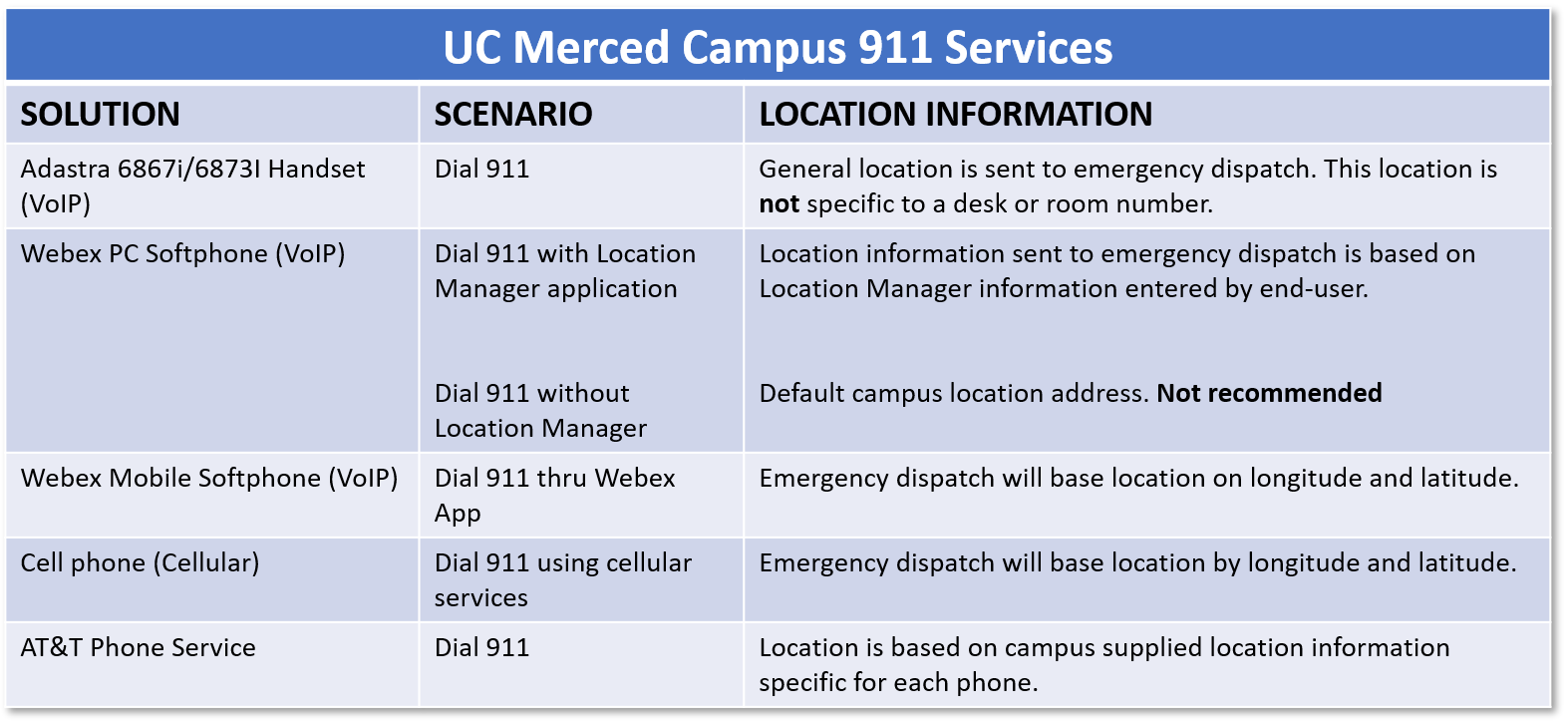VoIP service requests and changes are suspended pending the transfer to Zoom Phone on 12/10. To learn more, visit the Zoom Phone website.
What Is VoIP?
VoIP is an acronym for Voice-over-Internet-Protocol. VoIP is a unified communications service that provides voice integration with other services such as video conferencing, messaging, and data delivered via the internet over the campus wired and/or wireless network, or any data network to which a device can access.
Please see the FAQs for more information.
Disclaimer: 911 and Service Interruption
911 Service - Emergency 911 service using a VoIP device may be limited or unavailable for several reasons. The University of California, Merced, recommends always having an alternative means of accessing 911 emergency services. Emergency telephone calls would only be available by personal cellular telephone, with cellular emergency calls routed in accordance with the state 911 system protocols.
Service Interruption - In the event of a complete telephone system failure, the campus has no available backup or secondary telephone system to the campus VOIP system. Should the campus telephone equipment system fail, the Office of Information Technology would troubleshoot the outage. The contracted service provider will be consulted if a local resolution is unavailable.
If a resolution is unavailable, notification will be made to the Vice Chancellor of the Office of Information Technology and the Office of the Chancellor. The Emergency Operations Center (EOC) operates on the campus Voice Over IP (VOIP) system and is dependent on the network.
VoIP Basics
As UC Merced's preferred campus telephony solution, VoIP is new technology and a service that is also referred to as: IP telephony and internet/digital telephony. VoIP telephony allows you to make and receive telephone calls over the internet. Some popular examples of VoIP services are Teams and Zoom.
VoIP advantages include, but not limited to:
- Lower costs
- Increased accessibility
- Complete portability
- Higher scalability
- Advanced features
- Clearer voice quality
- Flexibility with softphones
VoIP News & Updates
November 16, 2022 - VoIP web page updated.
November 1, 2022 - Emergency service event.
September 29, 2022 - Intrado system training session.
September 23, 2022 - OIT announcement update, regarding project working efforts.
September 12, 2022 - Key stakeholders accepted, final approval to Go-live received.
September 6, 2022 - Disposition of Go-live project decision.
August 24, 2022 - Disposition of "Go/No-Go" project decision.
June - July 29, 2022 - Project team completes testing and validation for VoIP emergency dialing services.
May 5, 2022 - CAOs were provided updates regarding the upcoming changes to UC Merced’s telephony services, including VoIP users and how e911 services work.
March 18, 2022 – Project team implemented the enhancement SaaS solution and began emergency test dialing with goal to soft launch for VoIP users by end of May.
February 10, 2022 – Project team met with vendor for training to setup, configure and deploy the enhancement SaaS solution that provides “dispatchable location” information when the calling party dials 911.
January 22, 2022 - ANI/ALI records were sent to AT&T for update on their system of record. A memo was sent to the CAOs with a reminder to ensure any changes to telephony services are made by accessing
Training and Videos
For new VoIP users, please select the online guide, knowledge articles or video tutorial that is right for you.
VoIP Handset - Knowledge Article
Premium Phone (Model: 6867i)
Basic Phone (Model: 6863i)
WebEx
Location Manager
- How to setup and install Location Manager desktop app for Window users
- How to setup and install Location Manager desktop app for Mac users (COMING SOON!)
Videos
- Clearspan Communicator Softclient (10-minutes). User tutorial video that covers the Clearspan Communicator features and use.
- How to use AdAstra Model 6867i (17-minutes). User tutorial video that covers the 6867i VoIP handset feature and button use.
- How to use AdAstra Model 6863i (8-minutes). User tutorial video that covers the 6863i VoIP handset feature and button use.
911 Emergency Services
As of January 6, 2022, the Federal Communications Commission (FCC) mandate for the Ray Baum Act went into effect. Under Section 506 of Ray Baum’s Act, the Commission has adopted rules to ensure that “dispatchable location” is conveyed with 911 calls to dispatch centers, regardless of the technological platform used, including 911 calls from Multi-Line Telephone Systems (MLTS). Dispatchable location means a location delivered to the Public Safety Answering Points (PSAP) with a 911 call that consists of the validated street address of the calling party, plus additional information such as suite, apartment, or similar information necessary to adequately identify the location of the calling party.
Because of the various telephony platforms available on campus, please refer to the following chart for the solution, calling scenario, and usage expectations.

For more information on the Ray Baum Act, click here.
VoIP FAQs
For information on VoIP 911 Emergency Services FAQs at the UC Merced campus, click here!



